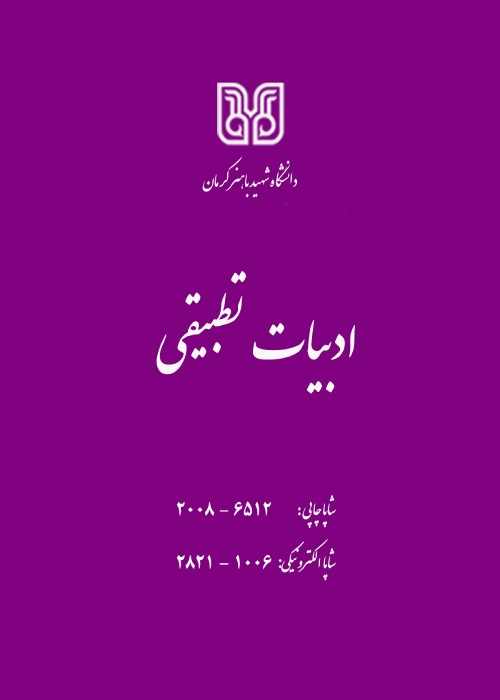A Comparative Study of Mystical Nostalgia Themes in the Poetry of Mohammed Ali Shams Al-Din and Attar of Nishapur
Investigating the links between Arabic and Persian languages and literature is one of the topics of comparative literature. The influence of Persian mystical literature on Arabic literature is very significant. Mohammed Ali Shams Al-Din is one of the contemporary Arab poets who has been influenced by the mystical thoughts of Attar of Nishapur. Therefore, the present study makes attempts to compare the poetry of these two poets with a reliance on the themes of mystical nostalgia; moreover, Attar's influence on this contemporary Arab poet and the extent of his innovation in borrowing are explained. The authors also try to prove that Shams al-Din is acquainted with Iranian-Islamic mysticism and its influence on Attar and its mystical themes, and because of its alienation from its true homeland and eternal lover, such as Attar uses symbolic language to express this kind of nostalgia. Of course, because of his familiarity with the flow of nostalgia in the Western manifesto, he also whispers to friends and mistresses of the earth and away from home. Therefore, the study attempts to examine the similar and different aspects of these two poets in expressing such nostalgia.
However, the social conditions of Attar and Shams al-Din are both troubled, and this has a profound effect on the expression of nostalgia in the poems of both poets.
This study attempts to compare mystical nostalgia in Attar's poetry (as the distinguished representative of mystical nostalgia in Persian literature) via a descriptive-analytical method and according to comparative literature.
Although nostalgia is a new terminology and often has a material and mundane sense, in mystical texts one can find some kind of nostalgia and sorrow that has a different meaning, that is, away from the true home of man, and in fact away from the origin of creation and the world beyond. That man will eventually return to that land. The mystical nostalgia or sadness away from the original homeland and heavenly lover is found in Attar's poetry. In fact, Persian poetry in those years was a legacy of despair due to the political and social turmoil of that time. In addition to his personal and psychological backgrounds, Attar's troubled times have also made him a nostalgic poet in Persian literature. This period had plagued the people of Khorasan since the beginning of the second half of the sixth century AH, which may have coincided with Attar's adolescence or youth. At that time Iran was going through one of its worst and saddest political, social and economic conditions. In the middle of the sixth century, the situation in Iraq and Khorasan became very disturbed. During the reign of Sultan Sanjar Seljuk Khorasan was at ease for some time, but with his capture by the Turks of Gaza in the year 550 AH he was in great disarray. The Ghaz Turks attacked Nishabur this year and slain Muhammad ibn Yahya, a Shafi'I Jurisprudent, along with thirty thousand people of Nishabur. Perhaps the most important issue that concerned Attar was the brutal attack of Ghazan and their brutal murder and looting that followed a strange famine in Khorasan, including Nishabur. Like Attar, Muhammad Ali Shams al-Din witnessed a period of crisis and turmoil in his land. The contemporary Lebanese poet is dissatisfied with the current situation in Lebanon because of the Zionist regime's struggle with the Lebanese resistance forces and occupying a part of his country, and in his poems speaks of his longing for his homeland, his mother, friends, and past memories. In a symbolic statement, he speaks of the difficult conditions of his country as a prey to sedition. Shams al-Din is a contemporary poet who, in addition to paying attention to mundane matters, has not forgotten his true origin and true beloved, composing poetry for his farness from his country. Thus, due to similar nostalgic contexts, such as the turbulent political, economic, and social conditions, Mohammed Ali Shams al-Din and Attar of Nishabur have portrayed mystical nostalgia with many similarities in their poems.
Shams al-Din is influenced by Islamic-Iranian mysticism, especially Attar's thoughts; therefore, mystical tendencies in his thoughts and poetry have become apparent, as he always speaks of mystical foreignness in his poetry, imagining his soul a flying bird.
Shams al-Din was familiar with Western poetic currents, and therefore, in keeping with the traditional nostalgia in the Western manifesto, he fell in love with his homeland and regarded it as a utopia that was left out of him and grieved over its departure and foreignness. It is worth noting that the concept of homeland in Attar's belief is quite mystical. He considers the earthly world a prison in which his soul is trapped and eager to fly to his original home. Unlike Shams al-Din, he did not love his hometown, and because he was not distant from Nishabur (his birthplace), sadness and sorrow are not seen in his poetry. Like Attar, Rumi and Suhrawardi, Shams al-Din speaks of his pure love to the true beloved. He uses the natural elements to express this thought and, like Attar, admires this fiery love. He also speaks of the pleasing pain of love. In addition, Shams al-Din's love sometimes becomes mundane, so that in love with his mother and friends, many poems are composed. Furthermore, both poets have also used the allegory of Layla and Majnun story of virtual love; and the two poets have given the allegory a mystical color, speaking of the union of the lover and the beloved as an allegory of true love. The concepts of mortality, survival, and alliance with the beloved are widely used in Islamic mysticism, including in Attar's works. Shams al-Din's poetry also show signs of this mystical thought. Like a mystic he seeks to survive near the Truth (God)
- حق عضویت دریافتی صرف حمایت از نشریات عضو و نگهداری، تکمیل و توسعه مگیران میشود.
- پرداخت حق اشتراک و دانلود مقالات اجازه بازنشر آن در سایر رسانههای چاپی و دیجیتال را به کاربر نمیدهد.




